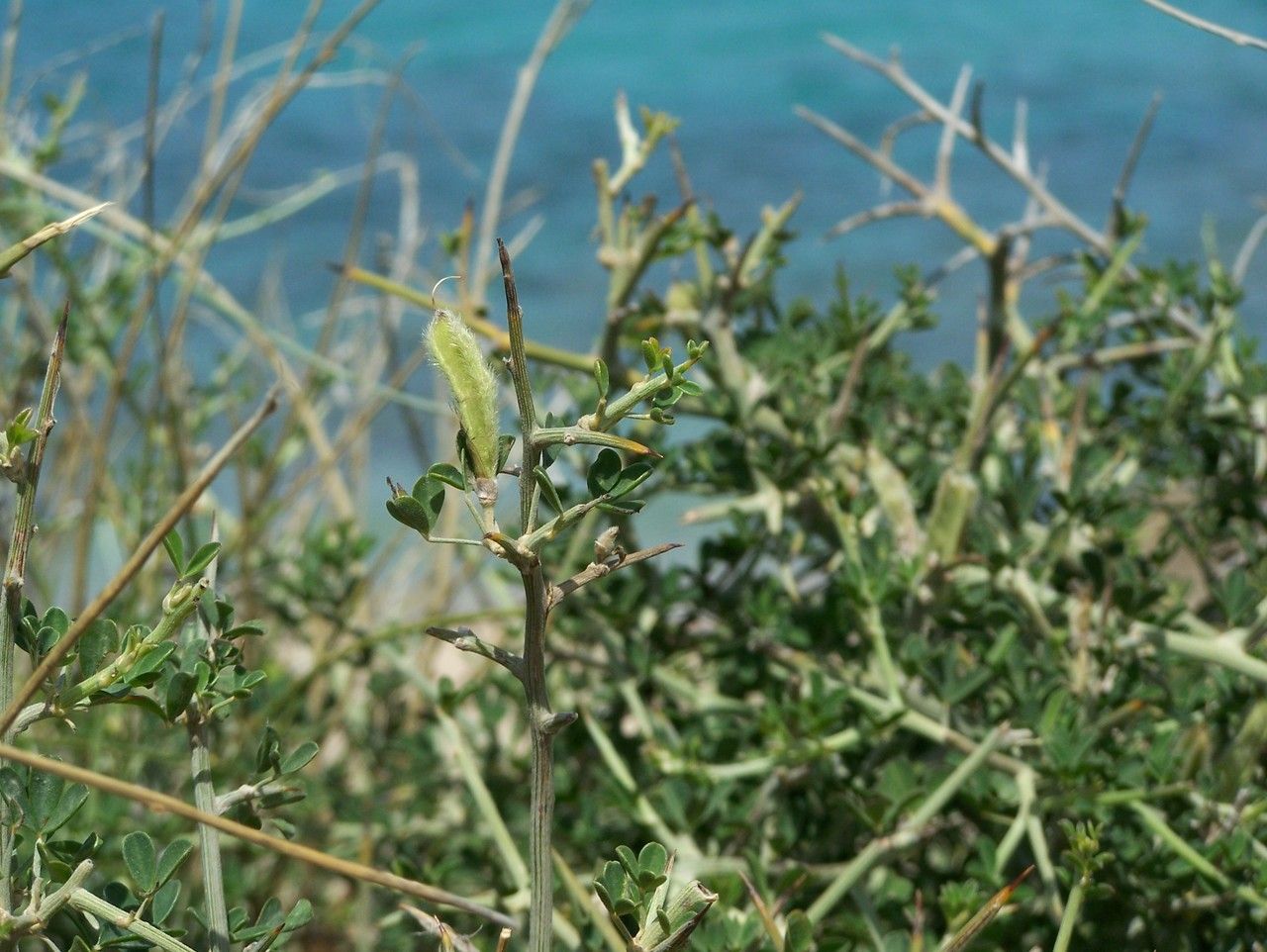Spanish Broom
calicotome villosa
Also known as: ["Spanish Broom","Villous Calicotome"]
Overview
A deciduous shrub native to the Mediterranean region, known for its bright yellow flowers and spiny stems.
Benefits & Perks
["long-flowering","drought tolerant","wildlife attractant (bees, butterflies, birds)"]
Botanical Classification
| Phylum: | Magnoliophyta |
| Class: | Magnoliopsida |
| Order: | Fabales |
| Family: | Fabaceae |
| Genus: | Calicotome |
| Botanical Name: | Calicotome villosa |
Plant Characteristics
Basic Information
- Category: Shrubs
- Suitable Location: outdoor garden in a sunny, open area
- Suitable For:
- Is Weed: No
- Allergenicity: low
Environmental Needs
- Climate: {"temperatureRange":"5–35°C"}
- Hardiness: {"zones":"8–10"}
- Misting: rarely required, only if ambient humidity is very low
- Drainage: Fast-draining to prevent waterlogging.
- Soil Type: Well-draining, sandy loam with some organic matter; cactus or succulent mix works well.
Maintenance Level
- Maintenance Level: moderate
- Toughness Level: high
- Pruning Frequency: Annually in late winter or early spring before new growth begins.
- Pruning Intensity: Moderate; remove up to one-third of the plant if overgrown.
Care Details
Ideal Sunlight Coverage:
Full sun (6–8 hours of direct sunlight daily); tolerates partial shade but may become leggy.
Sunlight Tolerance Tips:
Acclimate gradually if moving from shade to sun; protect from intense midday sun in summer; ensure good air circulation to prevent fungal issues.
Care Requirements
Care Difficulty
moderatemoderate
Sunlight
full sun
Rotate plant for even growth; use sheer curtains to filter harsh sun; place near south-facing window.
Watering
every 7–10 days during active growth, reduce in winter
Water thoroughly but infrequently; ensure soil dries out between waterings; avoid overwatering to prevent root rot.
Soil
well-draining, sandy or loamy soil
pH: Slightly acidic to neutral (pH 6.0–7.0).
Use gritty mix; avoid heavy clay soils; ensure pots have drainage holes.
Temperature
Prefers warm temperatures (65–85°F or 18–29°C); can tolerate mild frosts but thrives in heat.
Protect from frost; avoid sudden temperature changes; ensure good air circulation.
Fertilizing
every 4–6 weeks during spring and summer
Fertilize lightly; avoid over-fertilization; flush soil occasionally to prevent salt buildup.
Propagation
Methods
Stem cuttings or seed; stem cuttings are more reliable for home growers.
Step-by-Step Propagation Guide
- Take 4–6 inch cuttings.
- Remove lower leaves.
- Apply rooting hormone.
- Plant in medium.
- Keep moist and warm.
Best Time: Spring or early summer when the plant is actively growing.
Environment
Warm (70–75°F or 21–24°C), high humidity (70–80%), and bright indirect light.
Medium
Well-draining mix of perlite and peat moss or cactus mix.
Hormone
Rooting hormone is recommended to improve success rate.
Timeline
Roots may develop in 4–8 weeks; establish in new pot after 3–6 months.
Tools Needed
Pruning shears, rooting hormone, small pots, well-draining medium.
Quick Tips
Use healthy, non-flowering stems; maintain humidity with a plastic cover; avoid direct sun.
Pruning & Repotting
Pruning Guide
Method
Selective thinning of branches; heading back to encourage denser growth.
Pruning Plan
Prune to maintain shape, encourage bushiness, and remove dead or diseased growth.
Tools
Pruning shears, sterilizing solution, gloves.
Checklist
Sterilize tools; prune dead/damaged growth; shape plant; clean up debris.
Repotting Guide
Best Season
Early spring before active growth starts.
Pot Size
Increase pot size by 2–3 inches in diameter; avoid oversized pots.
Method
Remove plant gently; trim roots if needed; use fresh, well-draining soil; ensure good drainage.
Suggestions
Repot every 2–3 years or when roots fill the pot; beneficial for growth and health.
Checklist
Choose appropriate pot; prepare new soil; inspect roots; water after repotting.
Advanced Care Tips
Watering Mastery
Watering Checklist
Check soil moisture; water deeply; ensure drainage; avoid wetting leaves.
How to Apply Water Properly
Water directly at the root zone until water drains from the bottom; ensure even moisture without waterlogging; water in the morning to allow foliage to dry.
Watering Schedule Tips
Water deeply once every 1–2 weeks during active growth in spring and summer; reduce frequency to once every 4–6 weeks in fall and winter. Allow soil to dry completely between waterings.
Soil Improvement
Add perlite or coarse sand for drainage; incorporate compost for fertility; ensure aeration with chunky materials.
Temperature Stress Management
Signs of Temperature Issues
Yellowing leaves (cold stress); wilting or leaf drop (heat stress); stunted growth.
Cold Stress
Low temperatures slow growth and may cause root damage; prolonged cold can lead to dieback.
Solution: Move to a warmer location; provide frost protection in winter; avoid cold drafts.
Hot Stress
Excessive heat can cause leaf scorch, wilting, and reduced flowering.
Solution: Provide shade during peak heat; increase humidity; water more frequently but avoid waterlogging.
Fertilizing Guide
Fertilizing Checklist
Use balanced fertilizer; dilute properly; fertilize during growing season only.
Fertilizing Method
Use a balanced, slow-release fertilizer in spring; dilute liquid fertilizer to half-strength every 4–6 weeks during growing season; avoid fertilizing in winter.
Common Problems & Solutions
Toxicity Warning
Cats
Slightly ToxicCats may experience mild gastrointestinal symptoms if they ingest parts of Calicotome villosa. The toxicity is generally low, but caution is advised.
⚠️ Symptoms:
🌿 Toxic Parts:
⚡ Toxic If:
if eaten
Dogs
Slightly ToxicIngestion of Calicotome villosa seeds and roots can lead to mild gastrointestinal upset in dogs. The effects are typically not severe but should be monitored.
⚠️ Symptoms:
🌿 Toxic Parts:
⚡ Toxic If:
if eaten
Humans
Slightly ToxicCalicotome villosa contains compounds that can cause mild gastrointestinal distress and other mild symptoms upon ingestion. The physiological impact is generally limited to the digestive system.
⚠️ Symptoms:
🌿 Toxic Parts:
⚡ Toxic If:
if eaten
Frequently Asked Questions
Q: Is Calicotome villosa toxic to pets?
A: Yes, it is toxic to dogs and cats.
Q: Does Spanish Broom attract wildlife?
A: Yes, it attracts bees, butterflies, and birds.
Q: Is this plant drought tolerant?
A: Yes, it is highly drought tolerant.
Quick Reference
| Family: | Fabaceae |
| Care: | moderate |
| Light: | full sun |
| Water: | every 7–10 days during activ |
Get Expert Care Tips
Download the Plantious app for personalized care reminders and plant identification!
Google Play App Store








